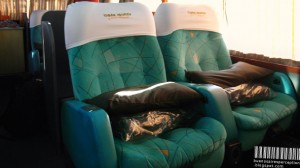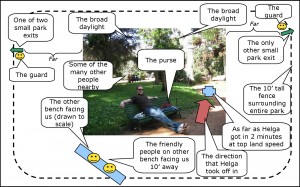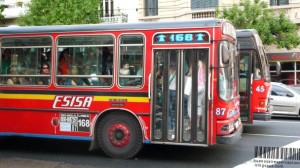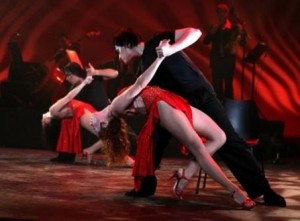So, we’ve been looking into planning a 3-day trip to Bariloche for next weekend, but after determining that it would cost ~$400 USD each for round trip plane tickets we decided it was time to sit down and figure out exactly how much we’ve been spending since we got here. Before I continue, it should be noted that the locals here all swear by the long distance bus system–apparently you can get executive class which has seats that lay flat and in addition to personal entertainment systems/movies, they feed you and give you free champagne. Now, that all sounds great, and it’s definitely a lot cheaper (more like $50/each), but I don’t care how “comfortable” it is, it’s still a 22 hour bus ride. Each way.

Now that I see it, I totally want to spend 22 consecutive hours in a seat like that...
So, after much discussion, we’ve decided that we are not going to spend 44 hours on a bus for a 3 day trip.

We used to spent 15+ hours a day in these kind of seats and no one brought us free champagne 🙁
So, we dug into our spending over the last month or so and our budget can basically be broken down into 4 broad categories (this may be a breach of the terms of our rehab–we made pivot tables):
Rent: $1200/month
Spanish School: ~$1220/month for the 2 of us
Food/random cash expenses: ~$1200/month or $40/day for the 2 of us
Tours/other excursions outside of day to day living expenses: Variable
1) Rent: $1200/month (USD)
We are now paying $1200/month on our 3-month contract. This is large 1 bedroom apartment with 1.5 bathrooms in a nice part of Recoleta and is at a well discounted daily rate vs. shorter term rentals (e.g., this apt. is listed at $100/day or $600/week) and includes all utilities + internet + weekly maid service. Depending on what neighborhoods you are willing to consider and how nice of a place you want you can get cheaper than this (or much more expensive). There seem to be “budget” apartments that range from ~$900-$1200/month for a 1 bedroom and are pretty hit or miss in terms of quality and “Luxury” apartments which are more like $1800+/month at a monthly rate and are significantly nicer. We are somewhere in between.
Currency issues: Apartments are pretty much always priced in USD and most want cash, so don’t expect to benefit from exchange rate changes as the prices are pegged to the USD.
Bottom line: We’re paying $1200/month, if we wanted to go cheap, we could have probably found an acceptable place for $1000/month, but it would likely be significantly worse than what we have. So I’d say that we are on the low end of what we could be paying. If you are here for a shorter time period, I’d budget $300-600/week–much better than hotels, but definitely not free.
Relative to San Francisco prices: ~33% of what we were paying in San Francisco, though hard to be apples to apples as that was a 12+ month lease and unfurnished.
2) Spanish School: ~$1220/month for the 2 of us or $610 each (USD)
We are attending Vamos Spanish for 20 hour/week intensive classes (and loving it–review to come). They charge US$150/week per person and it’s usually 1-4 people in your class which is pretty awesome. We looked at several other schools as well and the range seems to be $150-$200/week for 20 hours at the smaller schools, or you can go to the university where it is significantly cheaper, but much larger classes.
Currency issues: Spanish schools generally price in USD, but most allow credit cards or PayPal payments. Just don’t expect to benefit from exchange rate changes as the prices are pegged to the USD.
Bottom line: If you’re going to do intensive spanish classes, you should plan on spending at least $150/week. Can definitely get more expensive if you throw in private lessons which are more like $20/hour on average. That said, it’s definitely our favorite part of being here and well worth the expense to learn such a valuable life skill.
3) Food/random cash expenses: ~$1200/month or ~$40/day for the 2 of us. (USD)
This is by far the most volatile expense category for every day expenses and for us is easily 95+% food. We generally eat in a restaurant for 1 meal a day, sometimes 2 and the rest of the time either cook at home or eat left-overs. After our first couple of weeks of eating out all the time, more lately we’ve been averaging about $40/day (~AR$ 150). Here’s how it breaks down by meal:
Breakfast: Argentines aren’t that into breakfast. A typical Argentine breakfast, if they bother eating in the morning, is a coffee and a couple of Medialunas (basically a combination of a croissant and a donut). This will cost you ~AR$10-20 (~US$2.50-5.00) depending on where you get it. If you really want to splurge, you might get a Tarta (individual quiche) for ~AR$22 pesos, but that’s about the sum of your breakfast options. We generally eat cereal at home.
Lunch: Restaurant lunch prices can vary significantly and will typically run you anywhere from AR$30-50 (US$8-15) per person. There are 3 primary options:
- Basic: If you want to go cheap, you can often find a basic sandwich for ~AR$20-25 + a drink for ~AR$5-10 bringing you to a total of AR$25-35 (US$6-10).
- Menu del Dia: If you aren’t in the mood for a sandwich, most restaurants offer a ‘menu del dia” in which they’ll offer 2-3 options which usually include an appetizer + an entree + a dessert + a drink + a coffee for AR$30-40 (US$8-12). Very good deal assuming you like what they are offering. Quick tip: The “Menu del Dia” is always written on a sign outside the front door of the restaurant and rarely reprinted on the menu itself. So be sure to memorize the options before you go in!
- A’la Carte: Basically the standard dinner prices which vary by restaurant, but are often in the range of AR$30-60 per entree and AR$20-30/starter or salad. Basic drinks (soda, water, etc.) are usually ~AR$8, a beer will typically run ~AR$15 and a glass of wine is more like AR$18 for a solid pour. Quick tip: Always order wine by the bottle–very often, 2 glasses of wine cost more than the same bottle and they are always very happy to package up a bottle that you didn’t finish for you to take with you.
Dinner: Basically dinner is the same as the A’la Carte option from lunch. Assuming we don’t go somewhere super fancy, we’ll usually order a bottle of wine + one starter + 2 entrees and that will run us ~AR$120-140 for 2 or AR$60-70 each (US$16-18 per person) If we go to a nice place we’ll spend considerably more, that said, even at the nicest places we’ve probably maxed out at ~AR$300 (US$80) for the 2 of us–this is very expensive here, but keep in mind the same dinner would likely cost closer to double or triple that in San Francisco.
Alternative lunch/dinner: We have become huge fans of empanadas and usually have empanada night at least twice a week. You can usually get great empanadas for ~AR$4 each and it would be difficult to eat more than 3-4 of them each, so this is a very cheap dinner. We usually buy a dozen and then have them for 2 meals and there are empanada joints everywhere. Also, you can do the same with pizza, though it’s slightly more expensive and doesn’t offer quite the same quantity of food per peso as empanadas do.
Grocery stores: We aren’t in love with the grocery stores here. You can definitely eat cheaper if you cook at home assuming you have a decent enough kitchen and cooking utensils. That said, as a short-term renter, it’s unlikely that you’ll want to stock up on all of the spices and other cooking supplies that you’d want in order to make something you’d actually enjoy eating (spices are very expensive and hard to find here). Most packaged/processed food at the grocery store is relatively expensive and fresher food seems cheaper (e.g., ~US$5/lb for rib-eye steak, grass fed of course).
Wine: We drink a lot of wine. Wine is WAY cheaper here than it is in the US. Most stores have wine ranging from ~AR$8 up to ~AR$100 per bottle with the bulk of the offerings in the $AR20-30 range. We are now hooked on a AR$13.50 bottle (~US$4) which is quite good (and we are picky). Also, it’s great to try good wine in restaurants as there is only about a 10-20% mark-up vs. the 3x US mark-up. We save A LOT of money on wine here (though ironically drink less now that we are not consultants…)
Bottom Line: US$20/person is probably a decent estimate for what you’ll spend on average for food/drink. That said, for our first week or 2 we were probably double that, so if you’re here for a short trip you’ll likely spend more. You could definitely spend less if you put some effort into it, but we are certainly not splurging at US$20. Way cheaper than San Francisco, but it does add up.
4) Tours/other excursions outside of day to day living expenses: Entirely up to you
Most things that cater to tourists are expensive and priced in dollars, so proceed at your own risk.
In summary
It more expensive here than we had heard. Many friends who had visited even just a few years back enjoyed much lower prices–apparently prices have been increasing from 20-30%/year for the last several years. That said, it’s still a very cheap place to visit/live on a relative basis.
Here’s our average daily expense summary (keep in mind this is for the 2 of us):
Daily USD (peso)
Rent 40 (154)
School 41 (157)
Food/wine 39 (149)
Misc ? (?)
Total 120 (460)
Hope this is helpful. Happy to answer any questions!







